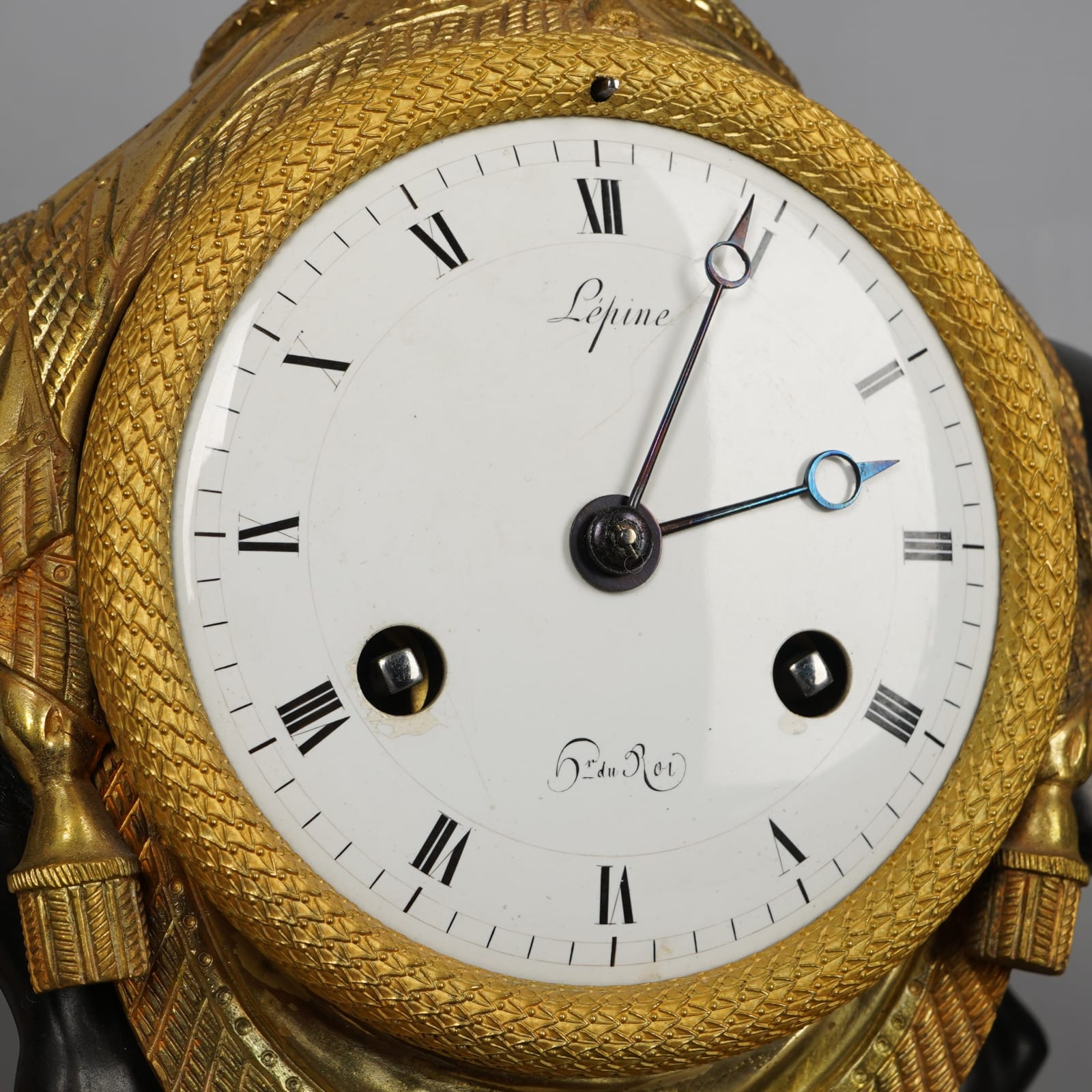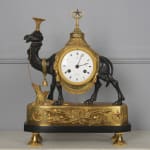Pierre-Claude Raguet-Lépine
Further images
Provenance
From a private Collection, Switzerland
A fine Empire gilt and patinated bronze pendule 'au dromadaire' of eight day duration by the celebrated clockmaker Pierre-Claude Raguet-Lépine, signed on the white enamel dial Lépine Hr-du Roi, the dial with Roman and Arabic numerals and a fine pair of pierced gilt brass hands for the hours and minutes. The movement with anchor escapement, silk thread suspension, striking on the hour and half hour, with outside count wheel. The superb and unusual case formed as a standing dromedary on whose hump is placed a stand surmounted by a crescent moon enclosing a star, the stand set upon a tasselled drapery swag that encircles the clock dial set within the main part of the animal's body, the dromedary with a bell hanging from its neck and a plumed headdress, standing above a tree stump on a stepped rectangular plinth with rounded ends, with elaborate frieze mounts comprising a pair of star and crescent moons flanking military trophies, supported on turned feet
Paris, date circa 1810
Height 36 cm, length 29 cm, depth 9.5 cm.
Condition: case partly restored.
Pendules 'au dromadaire' are extremely rare, the first of which were made in France during the early eighteenth century. The fascination with animals from faraway lands had been fuelled after the ambassador for the King of Siam gave an elephant, lion, tiger, camel and other zoological phenomena as a gift to Louis XIV in 1686. This inspired a number of bronziers to create clock cases featuring such exotic animals. While those with elephants or rhinoceroses were more common, those with camels or dromedaries were far more unusual. Interest in the latter once more came to the fore during the early years of the nineteenth century when artists, inspired by Napoleon's Egyptian campaigns, began incorporating Egyptian motifs and decorations within their designs. Since the present clock features the crescent moon and star, the ancient Turkish celestial symbol of power, it is possible that it was intended for the Turkish export market, which of course adds to its interest.
The name of Lépine is synonymous with precision clockmaking. This eminent firm was founded by Jean-Antoine I Lépine (1720-1814) but at the time that this clock was made, it was in the hands of the latter's son-in-law Pierre-Claude Raguet-Lépine (1753-1810), who was in many respects equally successful and renowned. Born in Dôle, Pierre-Claude married Jean-Antoine's daughter Pauline in 1782, having already invested 16,000 livres in his future father-in law's business. He then purchased a third share in 1783 and finally took over the concern at Place des Victoires No 12 in June 1784 at under the name of Lépine à Paris, Horloger du Roi and either signed his clock dials as such or simply as here without reference to the king. Prior to this he had worked as a compagnon to Jean-Antoine I Lépine and then in 1785 was received as a maître. Lépine-Raguet not only became prosperous from his clock productions but also dealt in diamonds and precious stones. His clocks and watches were of the highest quality and as such were supplied to the cream of society, including the comte de Provence and Louis XV's daughters at Château de Bellevue. He was also a member of the jury responsible for deciding upon a new Republican time system (1793); during the Empire he was appointed Horloger breveté de Sa Majesté l'Impératrice-Reine, 1805 and four years later was titled clockmaker to the Empress Joséphine while his other clients included Napoleon I, Jérôme King of Westphalia, Charles IV King of Spain, the princes Talleyrand, Kourakine (the Russian Ambassador) and Schwarzenberg (the Austrian Ambassador).





